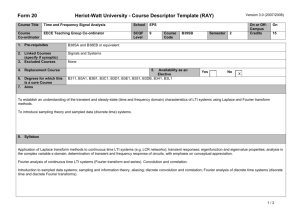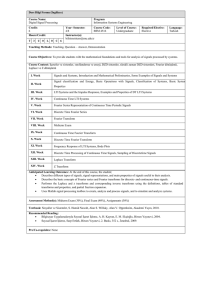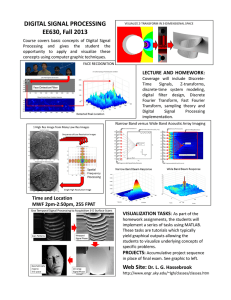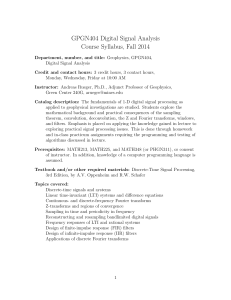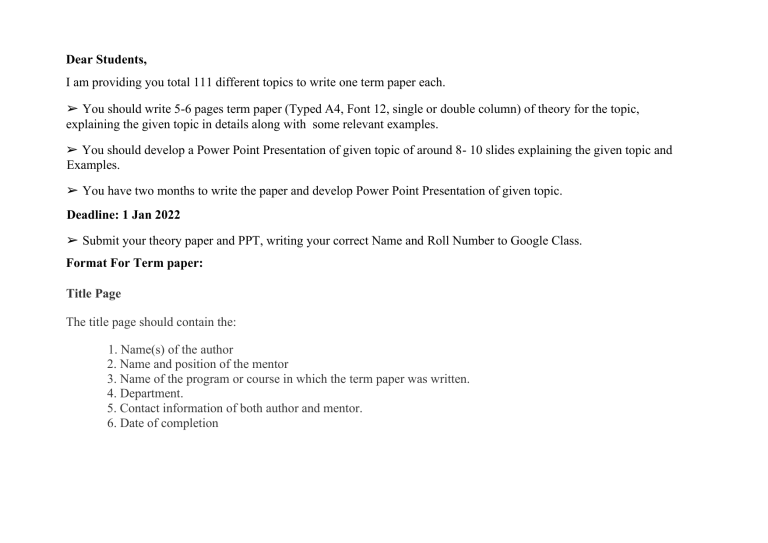
Dear Students, I am providing you total 111 different topics to write one term paper each. ➢ You should write 5-6 pages term paper (Typed A4, Font 12, single or double column) of theory for the topic, explaining the given topic in details along with some relevant examples. ➢ You should develop a Power Point Presentation of given topic of around 8- 10 slides explaining the given topic and Examples. ➢ You have two months to write the paper and develop Power Point Presentation of given topic. Deadline: 1 Jan 2022 ➢ Submit your theory paper and PPT, writing your correct Name and Roll Number to Google Class. Format For Term paper: Title Page The title page should contain the: 1. Name(s) of the author 2. Name and position of the mentor 3. Name of the program or course in which the term paper was written. 4. Department. 5. Contact information of both author and mentor. 6. Date of completion Term paper Organisation: Term paper organisation must be similar to the organisation of standard research paper with following sections Use IEEE research paper Format for writing term paper. 1. Title of the Term paper 2. Abstract 3. Introduction 4. Manuscript Body 5. Conclusion 6. Reference Each section is further explained below: Title of the Term paper: It should provide reader the name of topic on which you are writing the term paper. Abstract The abstract should be less than 150 words. It should indicate the: 1. topic to be investigated. 2. purpose of the study 3. methodology employed to study topic 4. major deductions 5. interpretations and implications of the study Introduction The introduction should provide the reader with all the background information needed to understand the paper. The author should explain key terms, give historical information on the topic studied, and cite other studies that have obtained relevant results. Manuscript Body This section contains the “core” of the paper. Ideally, it should be broken down into further sections such as core theory behind topic, mathematical background if any, literature review, or related study, your understanding of topic, and discussion. The author should use his or her discretion in dividing the body in the most natural way. Conclusion Your interpretations and implications of the studied topic References The references page should acknowledge all the resources used for obtaining information. The resource should be cited according to IEEE citation format. Examples of citations can be found on the author guidelines and resources found at IEEE author center website. https://ieeeauthorcenter.ieee.org/wp-content/uploads/IEEE-Reference-Guide.pdf Developed Power Point Presentation for the given topic should contain around 8- 10 slides, explaining the given topic and introducing some relevant examples aiding explanation. S. No. Roll no. 1 2 3 4 5 6 20116001 20116002 20116003 20116004 20116005 20116006 7 20116007 Aditya Singh AMIT KUMAR 20116009 MAHANT 20116011 Angajala.Sai Prassanna 20116012 Anil 20116013 Arjit Aryan 20116014 ARVIND KUMAR 20116015 Aryaman Singh 20116016 Ashif Raza 20116017 Badal jaiswal 20116018 Ganesh Bhukya 20116020 Bhupendra Singh 20116021 Bhupesh Kumar Gwal 20116022 Chanchal Dewangan 20116023 Chanchal Thakur 8 9 10 11 12 13 14 15 16 17 18 19 20 Name of Student Aanchal Sharma Abhay Upadhyay Abhimanyu kumar Abhishek Kumar ABHISHEK MODAK Parameshwar Ade Allocated Topic for Term Paper M Marks 10 Filter characteristics of LTI systems analysis using Transfer Function Fourier series representation of periodic CT signals and Discrete Spectrum Analyzing continuous time systems using Laplace Transformation Analyzing discrete time systems using Z-transforms Basic signal operations for CT and DT Signals Butterfly Structure for DIT FFT implementation for 32 point DFT Complex number representation in rectangular and polar form, and their relations Fourier Transform representation of aperiodic CT and Continuous Fourier Spectrum Continuous time LTI Systems and their Properties Continuous systems modeling using integro-differential equations Continuous Time System response to elementary Signals Convolution in CT domain, Convolution computation using different Methods Convolution in DT domain, Convolution computation using different Methods Fourier series representation of CT signals and Discrete Fourier Spectrum Discrete LTI systems and their Properties Discrete systems modeling using difference equations Discrete Time System response to elementary Signals Divide and Rule for FFT with different Radix DTFS for Periodic Discrete Time signals DTFT for aperiodic Discrete Time signals 21 22 23 24 25 26 27 28 29 30 31 32 33 34 35 36 37 38 39 20116024 Sadhvika chaparla manoj kumar 20116025 chodavarapu 20116026 David Choudhary 20116027 Deepakkumar 20116028 Deepshikha Sharma Devalla udaya durga 20116029 purna abhiram 20116030 Dinsha Jaiswal DIVYANSH 20116031 SHARMA 20116032 vineeth kumar Engili 20116033 Gajendra Kumar Tarak 20116034 Garima Singh Gattey Shanmukha Venkata Durga Surya 20116035 Prakash 20116036 Gaurav Ware 20116037 Geddada Chandrika GEDDAM UDAY 20116038 KIRAN 20116039 Genendra kumar Soni 20116040 Gopal Katankar 20116041 Raj kumar Gowrisetti Kedhar phanindra 20116042 sai.Gurram Elementary continuous time and discrete time signals Taxonomy of FFT Algorithms using periodicity and symetric properties of DFT FFT DIF, with complete implementation for 32 point DFT FFT DIT, with complete implementation for 32 point DFT Fourier transform analysis and synthesis of continuous time aperiodic signals Fourier analysis of continuous time systems and frequency response Fourier transform analysis and synthesis of discrete time signals Fourier transform of Periodic Signals and its relation with FS Fourier Transformation representation of aperiodic signals, Fourier transforms repersentation of power signals Frequency response of continuous time LTI systems, Frequency response of discrete time LTI Frequency Response of LTI Systems using Laplace transformation Hilbert transforms Ideal Filters and their realization Impulse response in time domain for CT system and its calculation Inverse Laplace transforms and its application in finding system response Inverse Z-transforms and its application in finding system response Laplace transforms of common signals elementary signals HITENDER SINGH CHANDRAKAR Hitesh Ishan Nayak Chaitali jadhav Kancharla Sai Harini Karimikonda Venkata Sai Harsha Vardhan 40 41 42 43 44 20116043 20116044 20116045 20116046 20116047 45 20116048 46 20116049 Ketan Rambhau Puyad 47 48 49 50 51 52 53 54 55 56 57 58 20116050 Khageshwar Singh Murali Krishna 20116051 kolagani 20116052 Rajesh Komaravalli 20116053 karthiksai.komatineni 20116054 Koragana Suresh 20116055 Kritagya Chouhan 20116056 Kuldeep Sahu 20116057 kuldeep sahu 20116058 Kushal Varma 20116059 Kaushik Prahaladh 20116061 Md Nehal 20116062 Meduru Sarath 59 20116063 Mohit Kumar Manual calculation of 4 point and 8 point DFT Mutual exclusive classification of signals and their examples N point DFT and Its properties Properties of CTFS and its application in determining frequency response Properties of CTFT, and its application in determining frequency response Properties of DTFS and its application in determining frequency response Properties of DTFT and its application in determining frequency response Properties of Laplace transforms and its application in determining system response Properties of Z-transforms and its application in determining system response Relation between Z and Laplace Transform System Properties and classification of System, Transmission of signals through LTI systems, synthesis and analysis Z-transforms of common sequences and their application to get closed form Filter characteristics of LTI systems analysis using Transfer Function Fourier series representation of periodic CT signals and Discrete Spectrum Analyzing continuous time systems using Laplace Transformation Analyzing discrete time systems using Z-transforms Basic signal operations for CT and DT Signals Butterfly Structure for DIT FFT implementation for 32 point DFT Complex number representation in rectangular and polar form, and their relation 60 61 62 20116064 Mudu Suresh 20116066 Rohitha Ravindra Myla 20116067 Nikhilesh Agrawal 63 64 65 66 67 68 69 70 71 72 73 20116068 20116069 20116070 20116071 20116072 20116073 20116074 20116077 20116078 20116079 20116080 Omshankar Dubey P NAVEEN KUMAR paladugu Sagar Palarapu Nikhil Paras Leela Potta vinay Pramil Kesarwani Pratham Gupta Prerak Jha Purvi Ghidora Pushkar Patel 74 75 76 77 78 79 80 81 20116081 20116082 20116083 20116084 20116085 20116086 20116087 20116088 Rahul Singh Rajasi Pandey Ram pravesh Rangabhatla Sriteja Reddi Keerthi Rishabh Verma Rohan lautre sameer rajesh sonwane Fourier Transform representation of aperiodic CT and Continuous Fourier Spectrum Continuous time LTI Systems and their Properties Continuous systems modeling using integro-differential equations Continuous Time System response to elementary Signals Convolution in CT domain, Convolution computation using different Methods Convolution in DT domain, Convolution computation using different Methods Fourier series representation of CT signals and Discrete Fourier Spectrum Discrete LTI systems and their Properties Discrete systems modeling using difference equations Discrete Time System response to elementary Signals Divide and Rule FFT with different Radix DTFS for Periodic Discrete Time signals DTFT for aperiodic Discrete Time signals Elementary continuous time and discrete time signals Taxonomy of FFT Algorithms using periodicity and symetric properties of DFT FFT DIF, with complete implementation for 32 point DFT FFT DIT, with complete implementation for 32 point DFT Fourier transform analysis and synthesis of continuous time aperiodic signals Fourier analysis of continuous time systems and frequency response Fourier transform analysis and synthesis of discrete time signals Fourier transform of Periodic Signals and its relation with FS Fourier Transformation representation of aperiodic signals, 82 83 84 85 86 87 88 89 90 91 92 93 94 95 96 97 98 99 100 101 20116089 SAMEER TRIVEDI SAMYAK BHUPATI 20116090 MESHRAM SANSKAR SUSHIL 20116091 KUMAR THENGARE 20116092 Sarthak Kumar Masta 20116093 Shalini Kashyap 20116094 Shivang Gupta 20116095 Shubham Sahu 20116096 SIDDHARTH PATIL 20116097 Smita Prajapati 20116098 Sridhara Phani Vaidik 20116099 Sujoy Banerjee 20116100 Surabhi Gupta 20116101 Tanvi khedkar 20116102 BHARGAV THOTA ANUSHKA 20116103 TRIBHUWAN 20116104 TRIPTI BANJARE 20116105 Utkarsh Maurya 20116106 Vardaan Agrawal V. Surya prakash 20116107 Yadav 20116108 Vinayak Tiwari Fourier transforms representation of power signals Frequency response of continuous time LTI systems, Frequency response of discrete time LTI Frequency Response of LTI Systems using Laplace transformation Hilbert transforms Ideal Filters and their realization Impulse response in time domain for CT system and its calculation Inverse Laplace transforms and its application in finding system response Inverse Z-transforms and its application in finding system response Laplace transforms of common signals elementary signals Manual calculation of 4 point and 8 point DFT Mutual exclusive classification of signals and their examples N point DFT and Its properties Properties of CTFS and its application in determining frequency response Properties of CTFT, and its application in determining frequency response Properties of DTFS and its application in determining frequency response Properties of DTFT and its application in determining frequency response Properties of Laplace transforms and its application in determining system response Properties of Z-transforms and its application in determining system response Relation between Z and Laplace Transform 102 103 104 105 106 107 108 109 110 20116109 Vivek Sharma 20116110 Yadavelly Dharmendra 20116111 Yash Sukhadeve 20116901 ADITYA DHOTE 20116902 ALKA SINHA 20116903 ARKITA DAM 20116904 MANSI DUBEY 20116905 PALAK SINGH 20116906 PALASH AGRAWAL 111 20116907 RAPA VENKATA SAI KAUSHIK System Properties and classification of System, Transmission of signals through LTI systems, synthesis and analysis Z-transforms of common sequences and their application to get closed form Filter characteristics of LTI systems analysis using Transfer Function Fourier series representation of periodic CT signals and Discrete Spectrum Analyzing continuous time systems using Laplace Transformation Frequency Response of LTI Systems using Laplace transformation Hilbert transforms Ideal Filters and their realization Impulse response in time domain for CT system and its calculation ➢ You have two months to write the term paper and develop Power Point Presentation of allocated topic. ➢ Submit your theory paper and PPT, writing your correct Name and Roll Number to Google Class. ➢ Contact me personally through mail in case of any confusion or clarification Dr. Ajay Singh Raghuvanshi, Head of Department, Subject Coordinator 3rd Sem ECE, Signals and Systems. Dept of Electronics and Communication Email: asraghuvanshi.etc@nitrr.ac.in Contact: +91 7587744881
